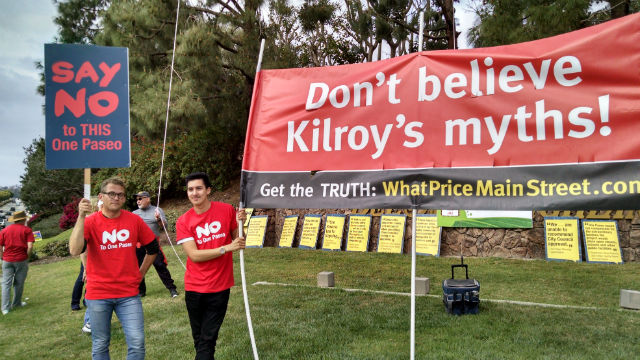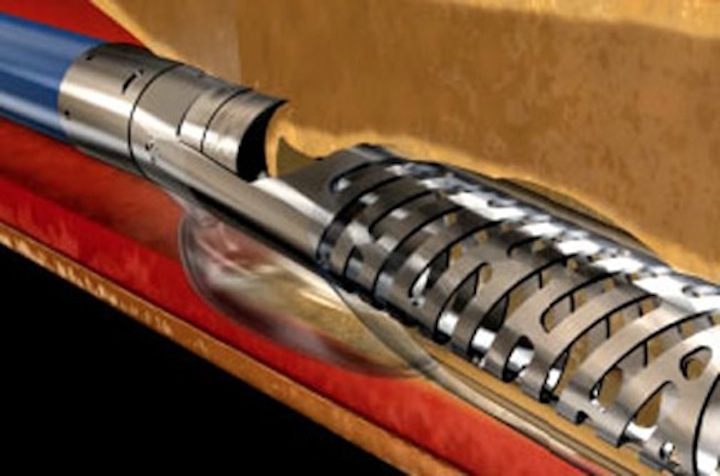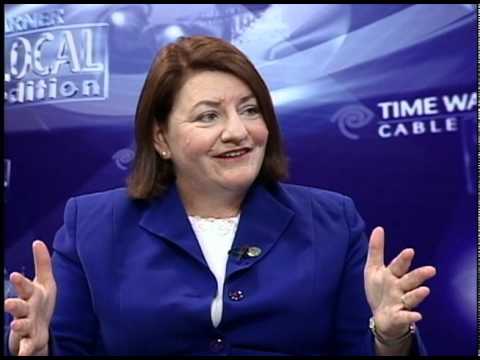Daily Business Report-Sept. 10, 2019
The median price of single-family homes reached $660,000 in August, virtually unchanged from where they were a year ago.
Home sales in San Diego County sluggish in August
August sales of previously owned homes in San Diego County slumped in the late summer heat, according to housing statistics compiled through the San Diego Multiple Listing Service by the Greater San Diego Association of Realtors.
Single-family home purchases were down 7.4 percent in August compared to July, and sales of condominiums and townhomes (attached properties) were 8.6 percent lower than the prior month. Compared to the same month last year, single-family home sales were down nearly 4 percent, and condos/townhomes were down 7 percent.
The median price of single-family homes reached $660,000 in August, virtually unchanged from where they were a year ago. Condo and townhome prices were up about a percent from July and are 3.5 percent higher than August of last year, standing at $440,000. For the year-to-date, prices of all properties are about 2 percent higher.
“The 30-year mortgage rates are approaching the historic lows of 2016,” said SDAR President Kevin M. Burke. “Whether that can give the housing market some relief is still dependent on an increase in our supply of homes for sale. Until then, buyers will have to be on their game.”
In August, the ZIP codes in San Diego County with the most single-family home sales were:
92128 (Rancho Bernardo East) with 55
92065 (Ramona) with 52
92057 (Oceanside North) with 51
92021 (El Cajon) and 92028 (Fallbrook), both with 48
92026 (Escondido North) with 47
The most expensive single-family property sold in August in San Diego County is an oceanfront estate in Del Mar. The 7,625-square-foot home was built in 1980, with an interior courtyard, swimming pool/spa, 5 bedrooms, 7 bathrooms, and a sales price of $22 million.
_________________
What to watch as California legislators
wrap up the 2019 legislative session
Endangered species, gig workers, children, universities, privacy, parolees who want to vote, people who want straighter teeth, and alligators. As California lawmakers return for the final week of the 2019 legislative year, the issues they take up will be sweeping and eclectic, as end-of-session to-do lists usually are.
More than 600-plus bills await final votes before Friday. Most have narrow potential impact. But a few will be noticed by everyone if they become law.
For instance, there are bills to require that manufacturers dramatically reduce plastic packaging. The plastic industry opposes that idea. Other legislation would cap rent hikes at 5 percent plus inflation. Realtors dislike that bill.
Few of this year’s crop of bills have attracted national attention. One exception is Sen. Nancy Skinner’s Fair Pay to Play Act, aimed at allowing student-athletes to profit from the use of their likenesses and to hire agents. The Berkeley Democrat’s bill would violate National Collegiate Athletic Association regulations barring student athletes from being paid.
Skinner and backers of the bill contend the NCAA makes billions, leaving the vast majority of players with nothing to show for their college playing days beyond debt and a degree. Basketball great LeBron James threw an elbow at the NCAA last week, tweeting to his 43.6 million followers: “Everyone is California- call your politicians and tell them to support SB 206! This law is a GAME CHANGER.”
The bill would affect colleges that earn $10 million or more in media rights to their sports programs. Stanford, University of Southern California, and University of California oppose it. The NCAA has warned that California schools may not be able to participate if the bill is passed.
_________________
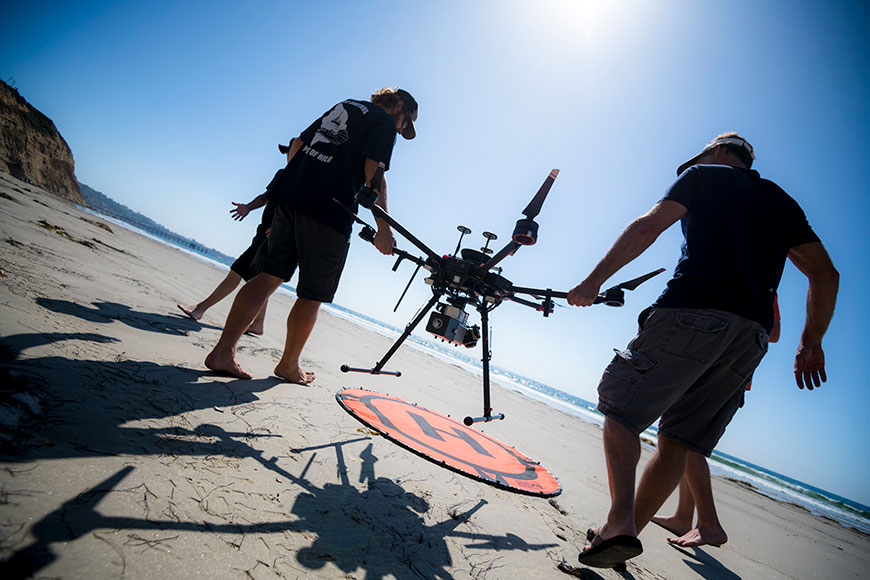
Scripps team uses sensor-laden
drone to measure coastal erosion
Scripps Oceanography marine tech Greg Boyd (left), research and development engineer Brian Woodward and others prepare to launch a LIDAR-equipped drone from a beach north of La Jolla. (Photo by Erik Jepsen, UC San Diego Publications.)
The drone will supplement efforts to monitor coastal erosion using a pickup truck equipped with a LIDAR system, researcher Adam Young
said. Light Detection and Ranging uses laser pulses to measure distances to make 3-D records of objects or terrain.
“The drone will help with areas inaccessible to the truck and can be used during high tides when the beach is too narrow. It will also be able to map features not visible from the beach such as the top of the cliff, and to monitor wave run up,” Young said.
_________________
Safe storage of firearms ordinance
goes into effect Thursday in San Diego
San Diego’s Safe Storage of Firearms Ordinance, which was approved by the City Council in July, goes into effect on Thursday. The law requires all residents of the city of San Diego to safely lock or store firearms that are inside their residences, unless the weapon is being carried on the body or in the immediate control of its owner or another authorized user.
City Attorney Mara W. Elliott, who authored the ordinance, urged gun owners to obtain approved trigger locks or safes and begin practicing safe storage now. Gun owners have many options under the law, and can choose a device at a price that meets their individual needs.
Free firearm safety devices are also available. A device was included with any firearms sold in California after Jan. 1, 2002. Requests for a free gun lock can be made through It’s Up To Us San Diego at https://up2sd.org/request-to-receive-free-lock/. In addition, Alzheimer’s San Diego offers free gun locks to families impacted by dementia. San Diegans can inquire about a free lock through this program by calling (858) 492-4400.
_________________
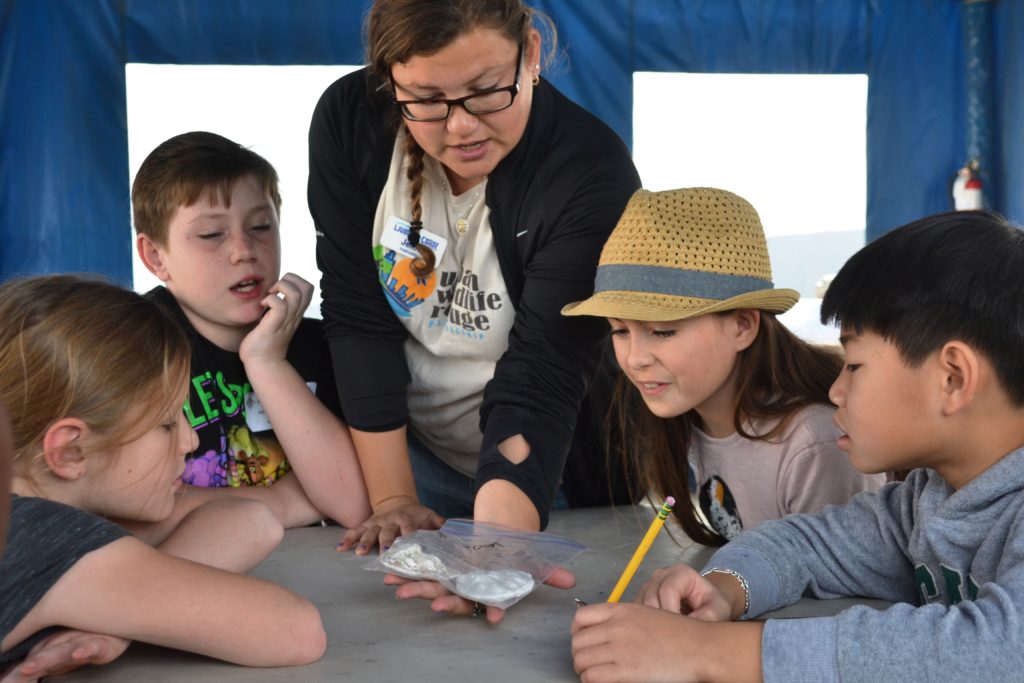
Living Coast Discovery Center awarded
$85,990 grant for wildlife program
The Living Coast Discovery Center, a nonprofit zoo and aquarium on San Diego Bay in Chula Vista, has received an $85,990 grant from the U.S. Fish & Wildlife Service (USFWS) as part of the SoCal Urban Wildlife Refuge Project.
The grant will enable the Living Coast to connect urban youth with nature and wildlife through a variety of programs, including field trips and refuge-based activities at the Sweetwater Marsh Unit of the San Diego Bay National Wildlife Refuge.
Students in grades three through 12 will be able to participate in the Refuge Living Lab, an interactive field trip led by a trained Living Coast educator that focuses on the importance of wildlife refuges and environmental conservation. Students will participate in a variety of experiential learning activities, including the planting of native vegetation, animal encounters, scientific experiments and trail hikes on the refuge.
Additionally, the grant will fund the Living Coast’s Sweetwater Safari program, which provides visitors with the opportunity to explore the refuge trails, use scientific tools and learn about local plants and wildlife on the Sweetwater Marsh. Groups can choose to participate in either educator-guided or self-guided tour options throughout the year.
_________________
UC San Diego rated the nation’s
10th best public university
The U.S. News and World Report Best Colleges Guidebook ranks the University of California San Diego the nation’s 10th best public university, up two spots compared to last year. The guidebook features a new ranking this year, “Top Performers for Social Mobility,” which named the campus 14th among U.S. public colleges. The category is based on how many low-income students enroll and their average graduation rate.
The publication also touted the campus’ Jacobs School of Engineering, which was named 11th among public engineering schools that offer doctorates.
_________________
2019 San Diego Electric Vehicle Day:
Largest test-drive event in the region
The annual San Diego Electric Vehicle (EV) Day – the largest test drive event of its kind in the region featuring the latest models of plug-in electric cars plus family-friendly activities – will take place at Liberty Station on Saturday, Sept. 14.
The free event offers an opportunity for the EV curious to test drive multiple cars in a no-hassle, no sales pressure environment, where they can learn not just about the latest automotive technology, but also get questions answered on how to charge, where to charge, where chargers are getting built, and special electricity pricing plans for EV drivers.
By driving a plug-in EV and enrolling in SDG&E’s EV-TOU-5 pricing plan, EV drivers can charge their cars overnight for the equivalent of paying 75 cents per gallon for gasoline.
San Diego Gas & Electric (SDG&E), Cleantech San Diego and the Center for Sustainable Energy, are co-sponsoring the event during National Drive Electric Week.
Event details:
Date: Saturday, Sept. 14, 2019
Time: 10 a.m. – 3 p.m.
Location:Liberty Station, Ingram Plaza, 2751 Dewey Road, San Diego, CA 92106


